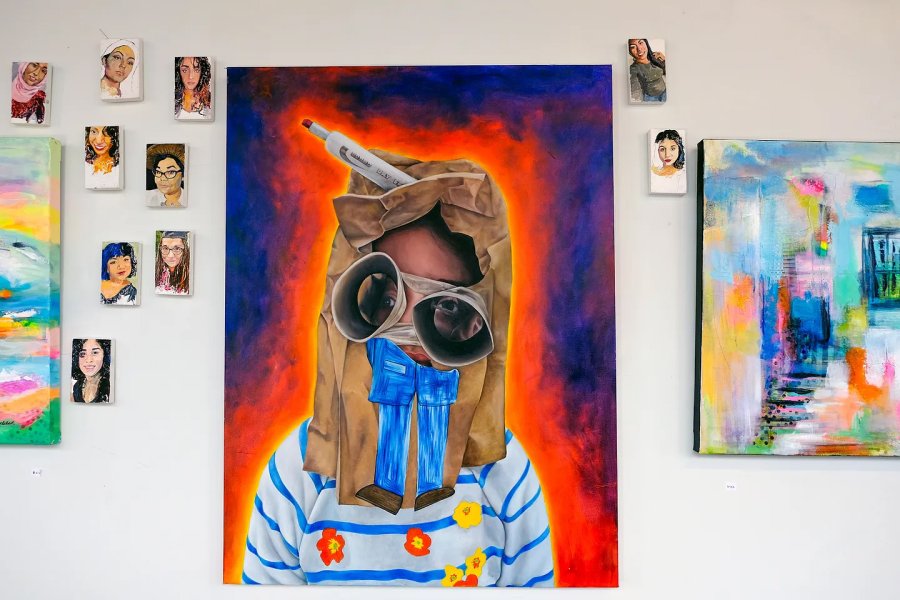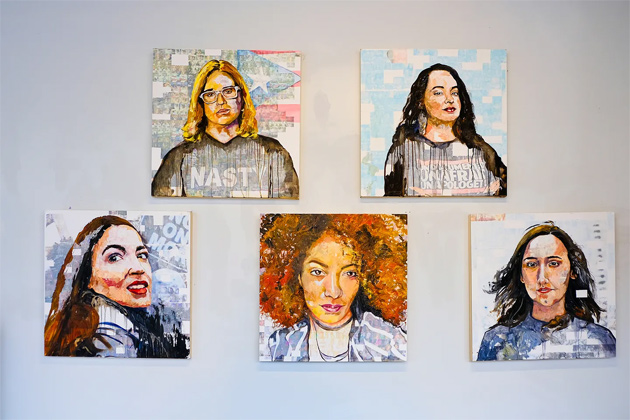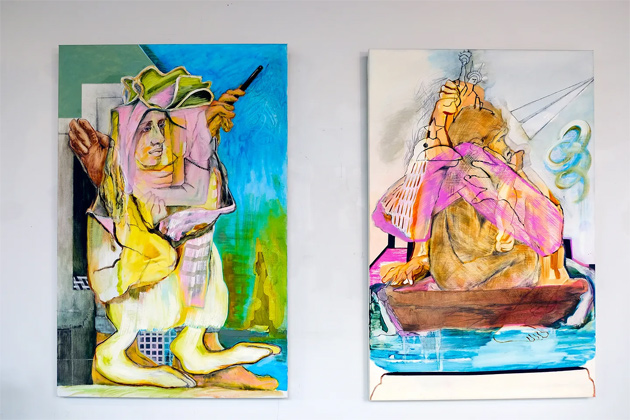
Raquel Fornasaro, "Big Boy Pants," photo by Sasha Patkin.
Latinx Identities: Struggles, Perspectives, and Critiques
Unbound Visual Arts Exhibit Gallery
43 North Beacon St., Allston
Through Nov. 17
What does it mean to be Latinx? What is the significance of heritage? And what does it mean to have a "Latinx History Month" when Latinx is an identity that exists year-round?
These were some of the questions curator Jessica Hernandez had in mind when she put out an open call for "Latinx Identities: Struggles, Perspectives, and Critiques," which is currently on display at the Unbound Visual Arts Exhibit Gallery at the Arthaus in Allston.
When the submissions came in, however, Hernandez says she was met less with an academic interrogation of these terms much more of a personal approach, as artists explored their own identities with art inspired by family, personal history, healing, and dreams.
Nayda A. Cuevas, "#FierceLatina":

Much of the artwork on display feels like a direct response to the exploration of identity, and multiple portraits dot the walls. At the entrance of the gallery, five 30x30 portraits by Nayda A. Cuevas open the exhibit. I jumped the gun a little in seeing this exhibition before its opening reception, so not all of the labels, descriptions, and artists statements were on the wall yet, but something about the graphic quality of the work and the care and attention given to each individual face made it clear that these were women who hold a certain amount of gravity. From information posted online, it seems that these women are all positive role models made visible and popular by social media, among them Alexandra Ocasio Cortez.
Nayda A. Cuevas, "#Latina: Reclaiming the Latina Tag:"

Several smaller portraits by the same artist lay on a table nearby, on their way to be hung on the wall - the exhibition catalog identifying them as "#Latina: Reclaiming the Latina Tag." These were selfie-sized, 3x5" portraits of women who had posted their photos on a Tumblr blog. Like the larger portraits, the images are stylized, textured by paint strokes, detailed shading, and sketched outlines. Some of the portraits feel unfinished, as though leading us toward a consideration of the process of becoming, while also slowing down the immediacy of social media and lending a consideration, consistency, and certain power to each that they may not otherwise have held. Knowing their origin as digital images, it was especially gratifying to see these portraits take some sort of permanent, tactile form, holding literal weight and presence in the world.
Jennifer Amadeo-Holl, "Mother of Exiles" (left) and "Love Letter to the Future" (right):

Other pieces approach the concept of identity through metaphor. In her pieces "Mother of Exiles" and "Love Letter to the Future" Jennifer Amadeo-Holl considers the Statue of Liberty as a prompt, playing on the statue's symbolism as both a beacon for safe harbor and the resonance it has in the shadow of the United States's complicated history of the acceptance and treatment of refugees. These pieces were layered both visually and emotionally, and I found the colors intriguing and inviting. Their tone was almost fantastical, and put me in mind of childlike storybook surrealism, like the wonderful and terrible adventures in Where the Wild Things Are as Max sails across the ocean to unfamiliar and unknown lands.
Still others take a more abstract approach. Ivonne Blanco's work explores the feeling of disorientation and adaptation that often comes as part of a Latinx identity. "I offer a perspective of confusion" she writes in her artist statement, "How can you successfully navigate an ambiguous world?… This is the dilemma of navigating this world as a Cuban-American." Her paintings, "Geogrametry" and "Between Two Worlds I and II," explore the concept of unsuccessful navigation and incorporate invented maps from Florida and Massachusetts layered with nonsense instructions.
The piece which caught me most off-guard was Raquel Fornasaro's "Big Boy Pants" - a large portrait with an electric orange haze surrounding what appears to be a child playing dress-up with a paper bag over their head, toilet paper rolls for goggles, and a dry erase marker poking out of the brim of their "hat." Paper pants appear to be taped to the front of the bag. There was no accompanying text for this piece, but something about it was delightfully and satisfyingly weird. It reminded me of the best parts of childhood and also those aspects of identity which are at once universal and yet completely individual, defying and transcending specific labels. Rather than a statement about Latinx culture, Fornasaro's portrait seemed to direct the conversation back to the humor, joy, and delight that comes with being human.
All the featured artists are Boston-based, but many of them originate from different countries, cities, and communities, and so speak to a broader sense of diaspora and identity. The diversity of media in the show - oil paintings, mixed media, photographs, film, digital art, and sculptures made out of recycled materials - speaks to how significant variation and diversity is possible even within a uniting theme, and further prompts exploration of the dialogue between Latinx identity and personal identity.
An opening reception for the exhibit is scheduled for this Thursday, September 28th, from 6:30 to 8 p.m. The artists will be present and available to engage with visitors, and the event will also feature music and refreshments. The exhibition will remain on display until November 17, 2023.
Review from the Independent Review Crew.
Like the job UHub is doing? Consider a contribution. Thanks!
Ad:
Comments
Latinx is not an identity shared by all Hispanics
By Frog
Thu, 09/28/2023 - 1:04pm
In fact, many people of Latin American descent--perhaps and most likely most people of Latin American descent in the USA--- reject the term "Latinx." Artists need to have their work shown. The "Latinx Identities" show, without acknowledging the rejection of the term and its colonial origins is a disservice. Although, perhaps, the rejection is best highlighted by the avoidance of the term's usage in the work. Even some of the titles of the art work here embrace terms like "Latina."
What does it mean to be Latinix?
By Waquiot
Thu, 09/28/2023 - 7:01pm
A dislike of the term would appear to be a part of it.
That said, it was a well written piece on an interesting art exhibition, poor name notwithstanding.
A lot of people dislike it
By ChrisF
Thu, 09/28/2023 - 11:05pm
I asked a long time friend that's Latina and she said " I think it's stupid. I'd rather you just call me a slur instead."
n=1
By SwirlyGrrl
Fri, 09/29/2023 - 1:10pm
1 != "a lot of people"
Is it really soooooo hard ...
By SwirlyGrrl
Fri, 09/29/2023 - 1:09pm
To respect the fact that exhibit self identifies and leave it at that?
I got hung up by the first line
By Waquiot
Sat, 09/30/2023 - 9:38am
And since I know Latinos, I knew of the controversy.
But was it sooooooo hard to read the rest of my relatively short comment and see that I did have things to say about the rest of the article.
But hey, I'll try to start a comment down the road with a phrase that the group to which it refers finds offensive and watch your reaction to it. On second thought, not even I could be that bad.
interestingly
By berkleealum
Fri, 09/29/2023 - 7:13am
neither is Hispanic
ī gess ī'll add ħat: mes
By schneidz
Fri, 09/29/2023 - 7:34am
ī gess ī'll add ħat: mes parents sont née á l'amérique-latine; mais, n'est pas hispanic.
And?
By Transphobia Watch
Fri, 09/29/2023 - 11:29am
The term was coined by a Latinx individual, as was Latine.
Of course a lot of people dislike moves to include people of all genders. I would venture a guess that a majority of English speakers dislike the move to use singular they in formal writing in order to include all people. Hell, this site won't make the switch and still insists in using binary-gendered language to refer to hypothetical people.
It doesn't really matter what the majority thinks. The majority doesn't get to have a say on the rights of a minority. What matters is whether trans and nonbinary folks wish to be included (yes, we do).
Your transphobia is showing when you see an inclusive term and say "but the majority of cishet people don't like including you." Yeah, no shit. We know they don't. Doesn't somehow make it just. But enjoy being on the wrong side of history.
Latinx? Are we still using
By anon
Thu, 09/28/2023 - 2:27pm
Latinx? Are we still using that term?
I thought most in the Hispanic community didn't care much for the term and preferred Latino.
Latinx was a term made up by white progressives.
No, it wasn't
By adamg
Fri, 09/29/2023 - 11:35am
But in any case, it's neither me nor the writer who used the term in relation to this exhibit - it was the exhibit's own curator who, at least judging by her last name, is in a far better position than we are to decide whether to use the phrase.
And who are you?
By lbb
Fri, 09/29/2023 - 1:02pm
And who are you to be citing "most of the Hispanic[sic] community" and calling it out?
Basic manners say ...
By SwirlyGrrl
Fri, 09/29/2023 - 1:08pm
If the artists are using "Latinx", then the person reporting on the exhibit uses "Latinx".
I think I'll start referring to you as a "anoknuckledragx" because my feels about what I think YOU should be called are more important than your self-identification. Because G_d forbid that I ever be expected to take a very simple step to respect other people!
ħa tərm brakes grammatikal structər
By schneidz
Sat, 09/30/2023 - 7:49am
devvellopt sins ānshənt roman empire bekuz ħa rule iz ħat ol (including nūtrəl) nownz must bee preceedded bī ħa femminnin or maskulin artikəl:
https://www.usnews.com/news/us/articles/2023-02-02...
Add comment